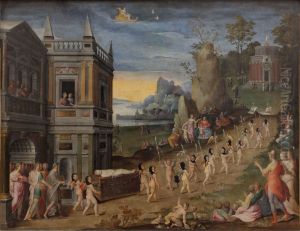Henri Lerambert Paintings
Henri Lerambert was a French sculptor and engraver born in 1568, during the Renaissance period, which was a time of great cultural and artistic flourishing in Europe. Not much is known about Lerambert's early life or training, but it is evident from his surviving works that he was a skilled artist deeply influenced by the artistic trends of his time.
Lerambert's career began to gain prominence in the late 16th and early 17th centuries. He was primarily known for his work as a sculptor, and his style was characteristic of the Mannerist movement, which followed the High Renaissance and was marked by elongated forms, complex compositions, and an often subtle distortion of perspective and proportion for effect.
One of Lerambert's most notable contributions was his work at the Luxembourg Palace in Paris, built for Marie de Medici in the early 17th century. Lerambert was responsible for some of the sculptural decoration within the palace, which is celebrated for its architectural beauty and historical significance.
Despite his contributions to the art of sculpture, Henri Lerambert remains a relatively obscure figure in art history, overshadowed by some of his contemporaries. Nonetheless, his works that do survive demonstrate a high level of craftsmanship and an understanding of the aesthetic and thematic preoccupations of his time. Lerambert's engravings also illustrate his versatility as an artist and contribute to our knowledge of the period's visual culture.
Henri Lerambert's death in 1625 marked the end of his artistic contributions, but his works continue to be studied by those interested in French sculpture and the Mannerist movement of the late Renaissance. Although detailed records of his life are scarce, Lerambert's artistic legacy offers insight into the artistic community of Paris in the late 16th and early 17th centuries.

